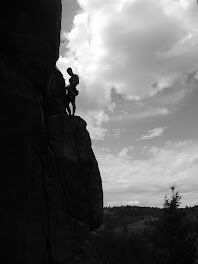I was inspired to write this post after reading Cecelia Ward Jones' article in the Jan/February 2010 issue of Poets and Writers magazine. In this article she chronicles her writing career and traces that she decided to be a writer at the age of nine having spent the day reading Little Women..which was thrust upon her by her grandmother after she complained of having nothing to do. At that same age I was reading alot too. Nancy Drew Mysteries, Five Little Peppers books, Bobbsey Twins, Black Beauty, My Friend Flicka, Dr. Seuss books, Scholastic Books, my mom's Reader's Digest Condensed Books, and a variety of other books. By the age of 17 had devoured Wind in the Willows, Catcher in the Rye, 1984, Watership Down, Atlas Shrugged, JRR Tolkein, Animal Farm, tons of science fiction and fantasy, I loved books and I loved to read.
Having established a life long love of reading..why do I write? in college my first composition class teacher assigned us poetry writing..I had never written poetry before but hammered out some lines.. and she loved them..she engaged in a long class discussion regarding them..I was exhilarated..I had never received such recognition for anything I had written before. I no longer have those poems but I am sure they were fueled by teen age angst and some lingering effects of a romance novel I had read. I have continued to have that sort of acknowledgment for my writing from my peers and others throughout my academic career. I have taken college classes, Writers Digest workshops, and attend various writer groups to better refine my writing skills. Therefore it must be that love of reading that is behind why I write, that recognition for what I write that drives me to continue to write today. Writing though is a fundamental tool for me to use in figuring out my world.
Writers have different processes of writing. Some can go straight to writing others carefully map out what they are going to write via an outline. I actually write most of my stuff out in long hand, then type it up or word process it into Google Docs. From there I transfer it via cut and paste to my blog. At least in this way what I write goes through to drafts..but I still know I am slack in the finer points of using just the right word. This is why I have recently been seeking out writers groups in Second Life to engage in dialogue and critique of my writing. I have listed some of these resources below:
Athena Isle Writers is for writers of all kinds to network, share contacts and information and meet writers, editors, and publishers. (Formerly Writers Wednesday.) We meet on Athena Isle EVERY Wed at 12pm SLT. Led by Alas Zerbino. Authors & expert guests booked by Cybergrrl Oh.
For writers who want to meet other writers to get inspired & rev up their writing business. Great writing job opportunities discussed. http://athenaislewriters.blogspot.com & http://slwritersclub.ning.com.
Virtual worlds writers group
Formerly The Guild of UK Writers. Group meetings held at Milk Wood. a featured Second Life Showcase site.
Incorporating all virtual writers' and literary group information. Helping keep your finger on the literary pulse.
milkwoodwriters.ning.com
The Learning Experience
Groups and workshops for writers of all kinds. Website here; http://www.tleinsl.com/index_files/CW.htm , in world The Learning Experience. According to their information: WHAT EXACTLY IS THE TLE WRITERS SYMPOSIUM?
These 2-hour sessions are a combination of open mic and writers' support/feedback group: Writers read their work aloud, and if desired, get feedback afterward.
Other events;
Daily writing topics for authors. We will post news about competitions we find noteworthy. We will also offer suggestions for daily field trips you can undertake in the real world. Finally, we’ll publish inspirational thoughts to keep you moving forward. Feel free to use the photographs on this site for your own purposes.
http://www.mammothgardens.com/wordpress/
Book Island in Second Life: Publishing Village for books, magazines and other resources for writers in Second Life. Here is a link to a recent article on Book Island.
And the Storm Mountain Writers Center in Second Life A place for writers! Serious fiction, poetry, creative nonfiction classes taught by professionals; critique & support groups; writers' hangout & coffeeshop (Hemingway Cafe); information source for entire SL writing scene, bookstore, Athen
So get inworld and check these places out... and remember ..don't stop writing.....


